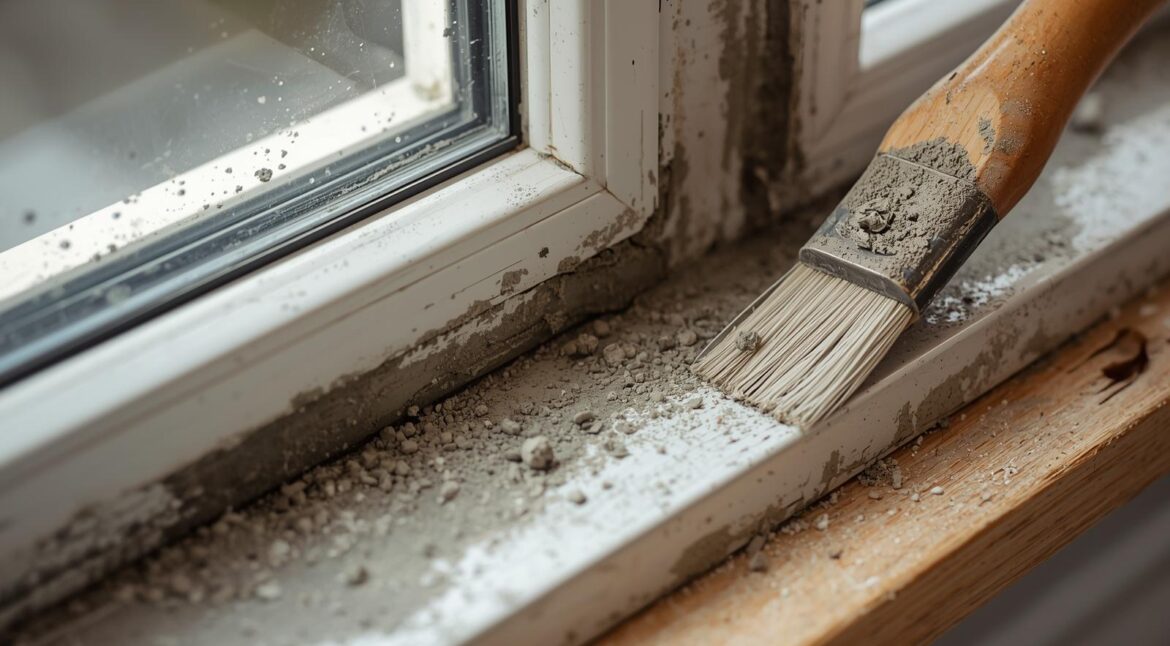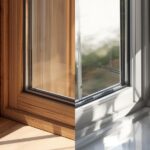Working with cement works near aluminium windows can quickly turn into a nightmare when concrete spatters and cement spots mar your crystal-clear view. During renovation and construction projects, stubborn blobs of dried cement inevitably find their way onto glass surfaces and aluminium siding, creating unsightly stains that seem impossible to tackle. The alkaline nature of cement allows it to bind strongly to any surface through hydration and chemical reaction processes.
What makes this particularly challenging is how cement can cure within microscopic pores, causing an etching effect that may permanently damage your property. However, with the right safe and effective techniques, patience, and proper tools, even professionals agree that this heavy work doesn’t require expensive worksite interventions. Understanding how alkaline substances etch and cloud metal surfaces is key to successful cement removal while maintaining clarity and peace of mind.
Proven Cement Removal Techniques & Step-by-Step Process
Initial Soap Solution Preparation
Fill your spray bottle with two to three drops of dishwashing soap mixed with water. Spray the window thoroughly to lubricate the surface and prevent scratches. Ensure soapy water completely saturate the cement – the porous nature allows it to absorb soap water, making removal significantly easier after several minutes.
Gentle Scraping Technique
Begin careful scraping using your plastic putty knife at controlled angles. Apply steady, light pressure in a controlled manner to lift away softened cement. Wipe off loosened particles immediately before you proceed to the next area. If traces remain after initial attempts, rinse with your garden hose and prepare for chemical treatment applications.
Chemical Remover Application
Apply non-acidic cement remover following manufacturer guidelines precisely. Some removal products are fluids requiring diluted mixing, while others come as aerosol spray. Avoid direct sunlight that causes remover to dry quickly – work in shade following instructions. Allow adequate time to soak, using a soft-bristled toothbrush to brush stubborn spots effectively.
Aluminium Surface Treatment
Prepare a mixture using a bucket with 4 litres of water plus a quarter cup of detergent solution. Using a scrubbing brush, apply this solution to aluminium sheeting and machining bars in circular motion for one to two minutes. Let sit for up to one hour before rinsing – stains become less visible.
Advanced Cleaning Process
For persistent cement stain areas, lay a cloth dampened with white vinegar and press against residue. Vinegar’s mild acidity helps break down residue – let soak 10 to 15 minutes, then scrub in circular motions. Commercial cement remover proves more potent for experienced DIYers. Rinse thoroughly with clean water, then wipe away stains and smudges.
Final Window Restoration
Complete the process by washing surfaces with standard window cleaner for optimal results. Dry completely using microfiber cloths to achieve streak-free, crystal-clear finish. For adequate clearance of difficult-to-remove deposits, a second cleaning session may prove necessary. Meticulously inspect for any remaining residue, ensuring chemical-resistant gloves protection throughout. The final result should restore complete transparency and dish soap effectiveness.
Essential Tools & Supplies for Effective Cement Removal
Essential Cleaning Tools & Equipment
Your toolkit should include a 1-gallon bucket, garden hose, and various sponges including soft sponge options for gentle cleaning. Paper towels and microfiber cloths are ideal for wipe-downs without leaving lint behind. A spray bottle ensures even application of solutions. Soft-bristle toothbrush, putty knife, and plastic scraper (specifically a plastic putty knife) are crucial for effective loosening without damaging surfaces.
Cleaning Solutions & Chemical Removers
Dishwashing soap and laundry detergent work as mild detergent options, while warm water excels at softening dried cement residues. Vinegar serves as an excellent eco-friendly solvent to dissolve and loosen alkaline substances effectively. For stubborn cases, visit hardware stores for specialized cement remover and concrete removing agent, following manufacturer directions carefully. Specialised glass cleaning solution completes your chemical arsenal.
Professional-Grade Chemical Options
Muriatic acid requires extreme caution as it’s highly corrosive – consider it a last resort best left to pros. This powerful solution demands careful handling and proper dilution techniques. Commercial cement remover proves more potent for experienced users but requires strict adherence to safety protocols. These harsh chemicals should only be used when gentle methods fail completely.
Safety & Protection Equipment
Always prioritize protective gear including gloves, goggles, and masks for glass work safety. Sturdy, chemical-resistant gloves shield your hands from harsh chemicals, while eye protection via safety goggles prevent cement dust and cleaning solutions from irritating your eyes. A dust mask protects against fine cement particles and fumes that prove harmful if inhaled during cleaning operations.
Critical Safety Guidelines & Protection Measures
Tool Selection Guidelines: Never use steel wool, abrasive sponges, or razor blades to scrape hardened cement from glass – these instruments create risks of permanently scratching surfaces.
Environmental Working Conditions: Avoid performing this procedure in sun where UV rays and heat dries cleaning solution rapidly, creating streaking that’s difficult to polish away.
Chemical Handling Precautions: Chemical residue left after washing may scratch delicate surfaces, potentially forcing you to change entire aluminium windows – methods avoiding muriatic acid are safer.
Personal Protective Equipment: Essential protective gear includes sturdy, chemical-resistant gloves to shield your hands, plus eye protection via safety goggles that prevent cement dust irritation.
Respiratory Safety Measures: A dust mask protects against fine cement particles and fumes from harsh chemicals that prove harmful if inhaled during vigorous cleaning operations.
Surface Protection Methods: Use non-abrasive methods and test any cleaner or solvent in an inconspicuous spot to ensure it won’t cloud or etch glass surfaces.
Application Technique Safety: Maintain steady hand control with scrapers – sharp angles or excessive force can create new marks or cracks causing irreparable scratches.
General Safety Awareness: Understanding that dried cement damage during installation is normal – just clean as soon as possible to prevent tiny particles becoming airborne.
Alternative Method
When conventional approaches don’t work, try creating a sugar solution in a small bowl—this method has proven effective for many situations. Using a rubber spatula, smear this thin paste across affected areas, giving the sugar adequate time to soften the concrete.
The scrubbing side of your sponge helps scrub the cement until it comes off completely. You may need to repeat this process on tougher splatters, applying additional paste as needed. Once satisfied with results, hose down your window thoroughly to rid all sugar residue and make sure every trace of concrete is completely gone.
Protecting Your Windows During Construction
An ounce of prevention proves worth a ton of cure when keeping cement off your windows in the first place – it’s far easier than removing it later. Practical tips include using cover windows with plastic sheeting or drop cloths whenever cement gets mixed or poured nearby. Seal gaps around window frames and sills using painter’s tape to catch any splatter before it reaches glass surfaces.
Clean spills quickly whenever cement does land on glass – wipe it away immediately using warm water before it hardens completely. Regular monitoring during construction and renovation projects means you should check windows daily, ensuring any cement spots get handled promptly before becoming permanent fixtures.
Restoring Your View, Protecting Your Investment
Dried cement on glass windows doesn’t need to become a permanent eyesore regardless of whether you’re a homeowner, contractor, or property manager. There are clear, step-by-step methods to eliminate cement stains safely by harnessing the power of gentle scraping, mild solvents like vinegar, and specialized removers.
Sometimes leaning on expert services when the job demands it helps restore your window’s clarity and maintain its value for years to come. If you find yourself feeling overwhelmed or needing a professional touch, local expertise ensures each pane of glass gets handled with utmost care. Don’t let stubborn cement marks compromise your view or your property’s curb appeal – with the right approach and quality services, you’ll be gazing out of pristine windows once again, completely cement-free and worry-free.
Conclusion
Removing cement from aluminum windows may seem overwhelming, but with the right tools, safe techniques, and patience, you can restore both clarity and shine without damaging the surface. From gentle scraping to eco-friendly solutions like vinegar and sugar paste, every step helps safeguard your investment and preserve window quality.
However, if stubborn stains persist, turning to experts is the smartest choice. For professional assistance and durable aluminium window solutions, contact Fam Aluminium today and let us help you protect and enhance your property with confidence.





